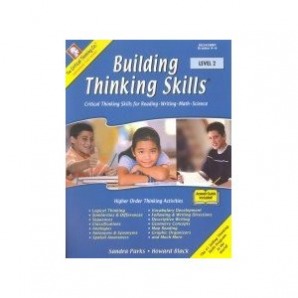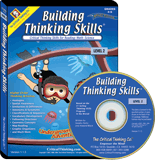Review: Building Thinking Skills
|
The Critical Thinking Company, known also as Bright Minds, has been around in the educational community for many years. I remember seeing their books and items in educational supply catalogs when I was teaching in the public school system in the 1990s. The particular book I’d like to tell you about is called Building Thinking Skills, Level 2, written by Sandra Parks and Howard Black. It is a 408-page paperback book with a glossy cover for protection. This book covers critical thinking skills for reading, writing, math, and science. Its higher order thinking activities cover the following skill areas: |
- logical thinking
- similarities and differences
- sequences
- analogies
- antonyms & synonyms
- spatial awareness
- vocabulary development
- following & writing directions
- descriptive writing
- geometry concepts
- map reading
- graphic organizers
- and more
Building Thinking Skills, Level 2 targets students in the 4th through the 6th grades. In this particular series of critical thinking skills books, there are levels designed for students from early elementary school (Beginning and Primary levels) through high school (Level 3 Figural and Verbal). Hint: Think “Preparation for the SAT or ACT” here!
When I first sat down with this book to look through it and get a first impression, I noticed that the company’s telephone number is on the title page. I like that. Obviously, if I have questions or need help or suggestions, they want me to contact them. Nice! For those of you who would like to use this book with more than one child in your family, home school, or classroom, this particular level has the following quote:
“The individual purchaser of this book is licensed to reproduce the student pages for use within one home or one classroom.”
Wonderful! I don’t know if all of Critical Thinking Company’s books make this offer, but I was thrilled to see this kind of statement made in what could easily be considered a consumable text. For my two children, I chose to not photocopy the book, because that would be much more expensive, especially considering the number of pages in the book. I figured at 9 cents per page, it would have cost me about $33. (The 39-page answer guide at the back of the book is not included in these prices.) For my personal time it would take to photocopy this book, I would be better off purchasing another copy at $30 (retail price) than to spend a couple of hours' work away from home just to save $3.
There are 10 chapters in this book, each covering a different type of critical thinking skill. My children and I have worked through over half of this book. We choose to do 2-4 pages several times a week at home, and that has worked well for us. One of the girls stays with me and completes her pages in this book, while the other girl goes into another room so as not to hear the answers, and works on another school subject or project.
The book is so simple to use. In fact, it seemed too simple as I flipped through the first few pages and realized there were no directions or instructions that came with the book.
At the beginning of each page, there is a simple one- to three-sentence set of directions. Even though my children had not done any of the specific skills before, and they found some of the pages challenging, they enjoyed figuring out what they were supposed to look for, answer, or draw. These workbook pages have really made them think outside of the typical schoolbook or workbook! My children could easily work through the pages themselves and come find me when they need assistance, but I enjoy finding the answers myself (!) and observing the girls coming to the proper conclusions. They seem to like the interaction with me while we are working through the book.
Both girls eagerly grab the book each school morning, so I would say that it’s definitely not drudgery to them!
The only thing I wasn’t certain about when starting to work through the pages of the workbook was whether it would be more beneficial to do one page out of several different sections in the book each day, or if it is better to work page by page through the book as it is laid out. I decided that since the book is laid out page by page, that is what I would do, too. I would like to suggest, however, that in future editions, they print out a teacher suggestion section by the title page or the table of contents that would explain the most appropriate method of working through the book, or providing several scenarios of how it could be used in the classroom or in a family home schooling situation.
The only other suggestion I could come up with for this great book is that the company might want to include some “dot paper” blank pages that could be photocopied and used for the “Figural Similarities and Differences” section for families who want to use the book for more than one person. We happened to have a package of cheap “dot square” cards that came with a Dot Square game from a dollar store here in town, and instead of me drawing out dot paper of my own, we wrote on some of the unused dot square paper cards in that game.
If you are interested in encouraging your children to think “outside of the box”, then I think you’ll find this book to be an excellent tool to use in your home or classroom.
It’s nice to be able to highly recommend this easy-to-use resource.
As a side note, they also now have this product on CD-ROM for $36.99.
DISCLOSURE: Any products reviewed by me as a member of the TOS Homeschool Crew have been given to me free of charge in order for me to provide you with an honest review of the product and/or how we used the product within our family. I do not receive any other form of compensation for the reviews posted on this blog.




